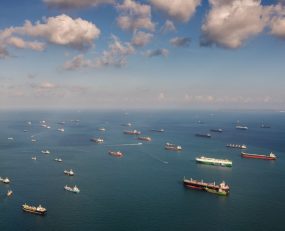
Following calls for actions and scientific pressure, in 2023, Europe is introducing new legislations to mitigate and offset the impact of climate change.
The maritime transportation industry is the backbone of world trade. It is the most cost-effective way to move heavy loads such as oil, grain, minerals, and containerized cargo over long distances. However, it accounts for 3% of global greenhouse gas emissions (GHG).
The International Maritime Organization (IMO) predicted in a 2015 study that if no action is taken, CO2 emissions from the industry could increase by up to 250% between 2014 and 2050. As a result, it has pledged to reduce international shipping’s carbon intensity by 40% by 2030 compared to 2008.
One of the policies that will go into effect this year is the EU’s Carbon Border Adjustment Mechanism (CBAM), which has divided opinion internationally, as Professor John Manners-Bell described last week.
Additionally, starting on January 1, 2023, exhaust emissions from ships of 400 gross tonnages (GT) or more registered in MARPOL signatory nations will be measured using a scale called the Energy Efficiency Existing Ship Index (EEXI).
EEXI aims to assess the vessels’ energy efficiency and begin data collection of their annual operational Carbon Intensity Indicator (CII). Carbon intensity links GHG emissions to the amount of cargo carried over a given distance.
The implementation of mandatory EEXI and CII is part of the 2018 IMO Short-Term Strategy for Reducing GHG Emissions from Ships. A ship’s carbon intensity will be rated A, B, C, D, or E based on its CII (where A is the best). The rating indicates the level of performance, which will be documented in a “Statement of Compliance” that will be expanded upon in the ship’s Ship Energy Efficiency Management Plan (SEEMP). For instance, a vessel rated D for three consecutive years or E for one year will have to submit a corrective action plan.
To get a higher rating, a ship can run on low-carbon fuel. Nonetheless, additional actions like hull cleaning to lessen drag, route and speed optimization, installing energy-efficient lightbulbs, and installing solar/wind auxiliary power for accommodation services might help the rating.
These three regulations are already sparking discussions among shipping contract parties such as ship owners, operators, and charterers.
Despite all preparations, the new carbon regulations may result in several legal disputes involving existing contracts. Many ships, for example, will have to slow down or change their operational pattern, implying that time charter contracts must be flexible.
Legal experts agree that shipping stakeholders must start figuring out how these new rules will affect existing contracts and shape new ones. As a result, shipowners and charterers will almost certainly need to collaborate like never before to comply with these newly already discussed regulations.
One clear thing from these changes is that these new laws will impact the sector, and it is worth keeping an eye on the domino effect that the new legislation will create.
For more in dept-information, download the Ocean Freight Rate Tracker: Q4 2022 Whitepaper, which provides transparency on current sea freight rates, capacity, congestion and container availability by trade lane. The paper also maps out expected rate development for each quarter and out to 2023.
Supply chain strategists can use GSCi – Ti’s online data platform – to identify opportunities for growth, support strategic decisions, help them stay abreast of industry trends and development, as well as understand future impacts on the industry.
Visit GSCI subscription to sign up today or contact:
Michael Clover for a free demonstration: [email protected] | +44 (0) 1666 519907
Source: Transport Intelligence, 20th January 2023
Author: Marta Chiriatti